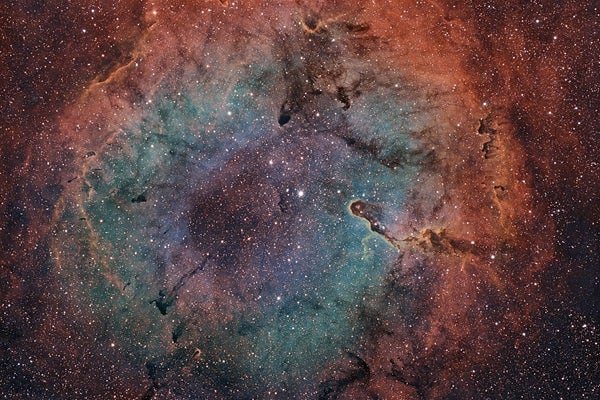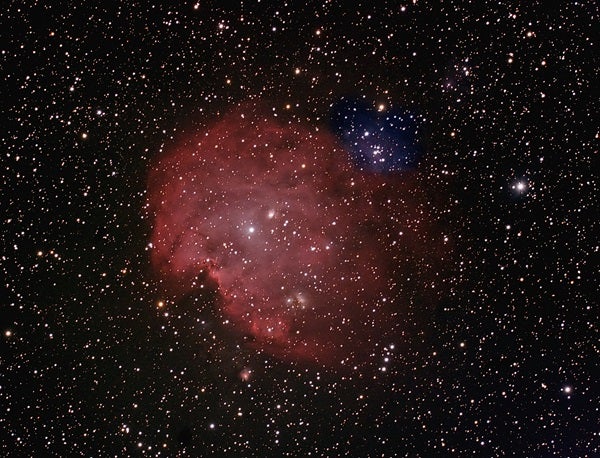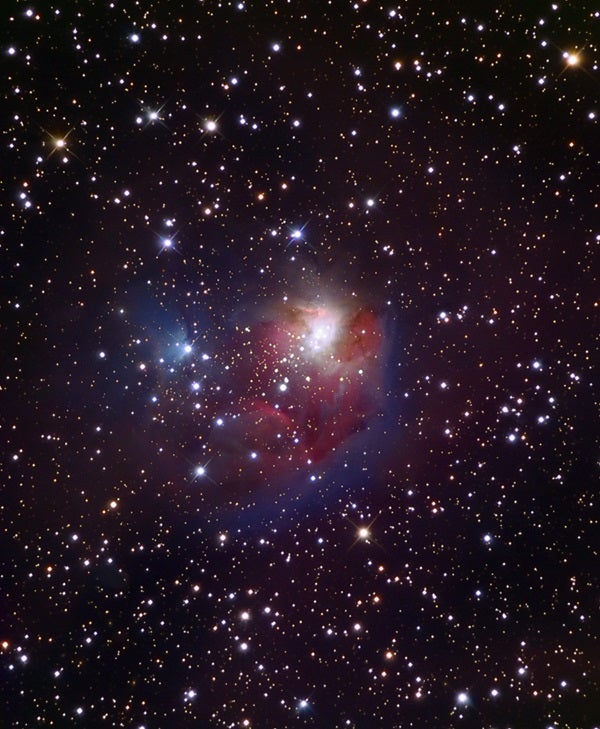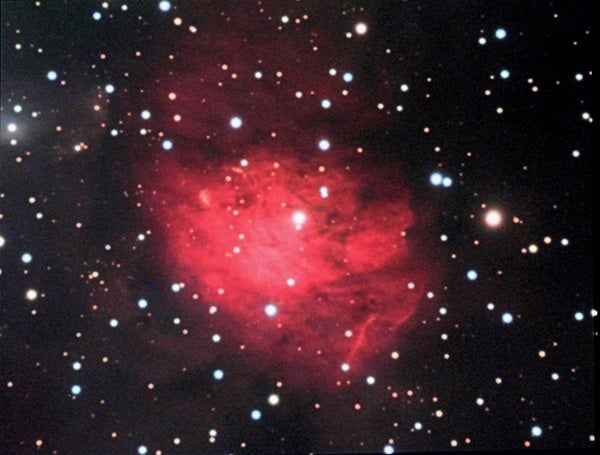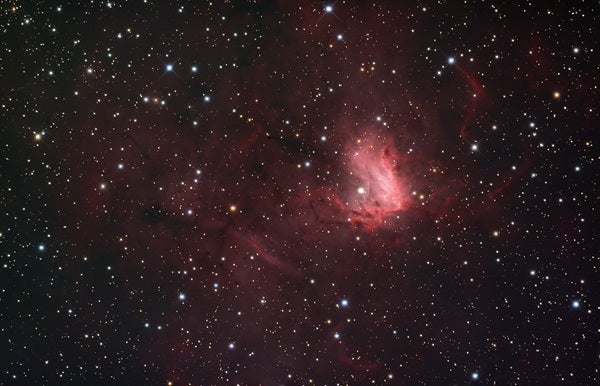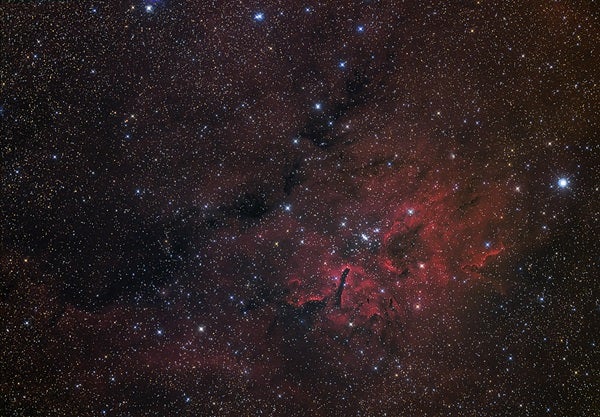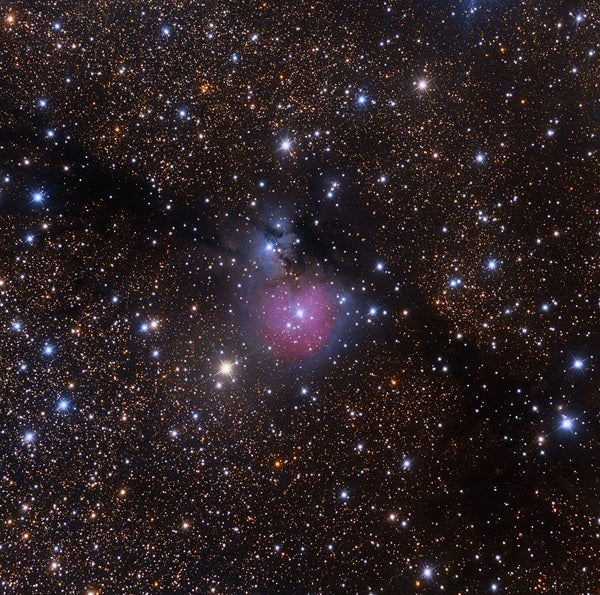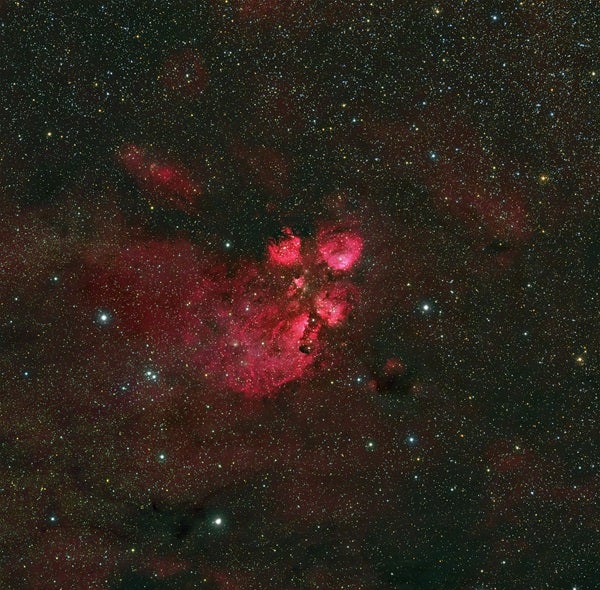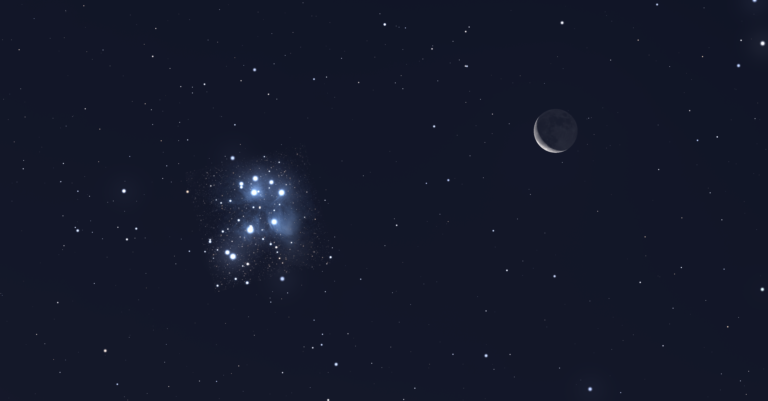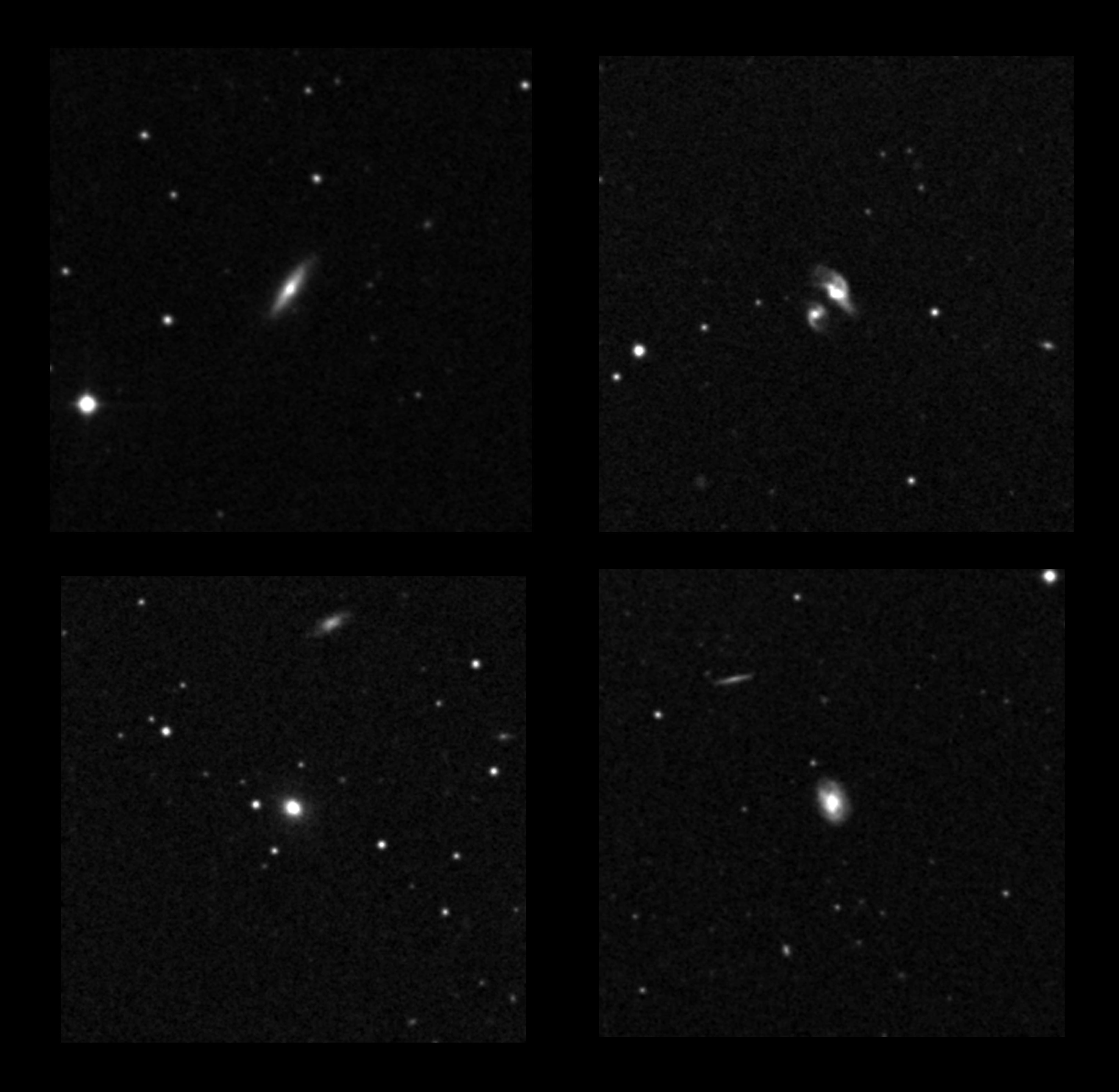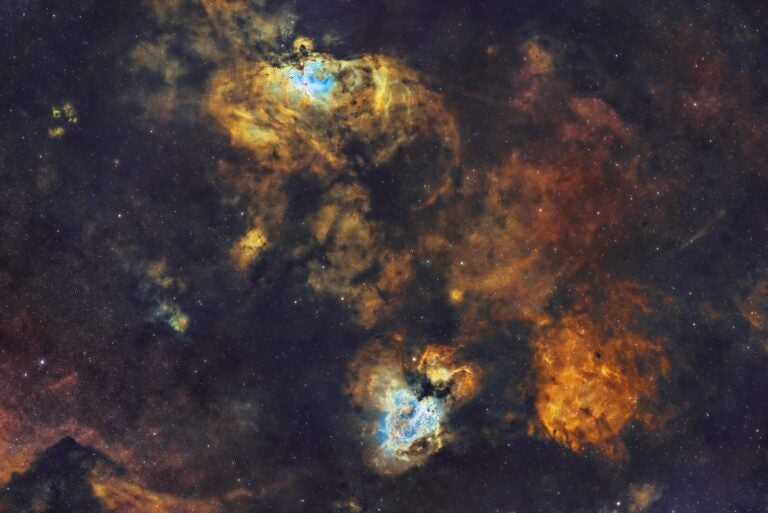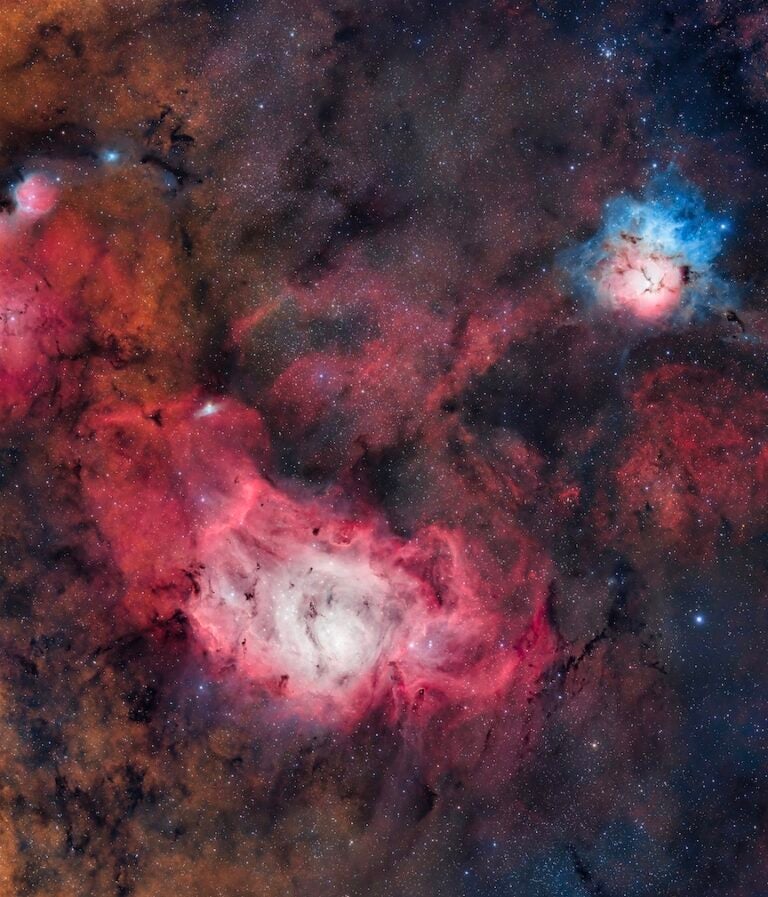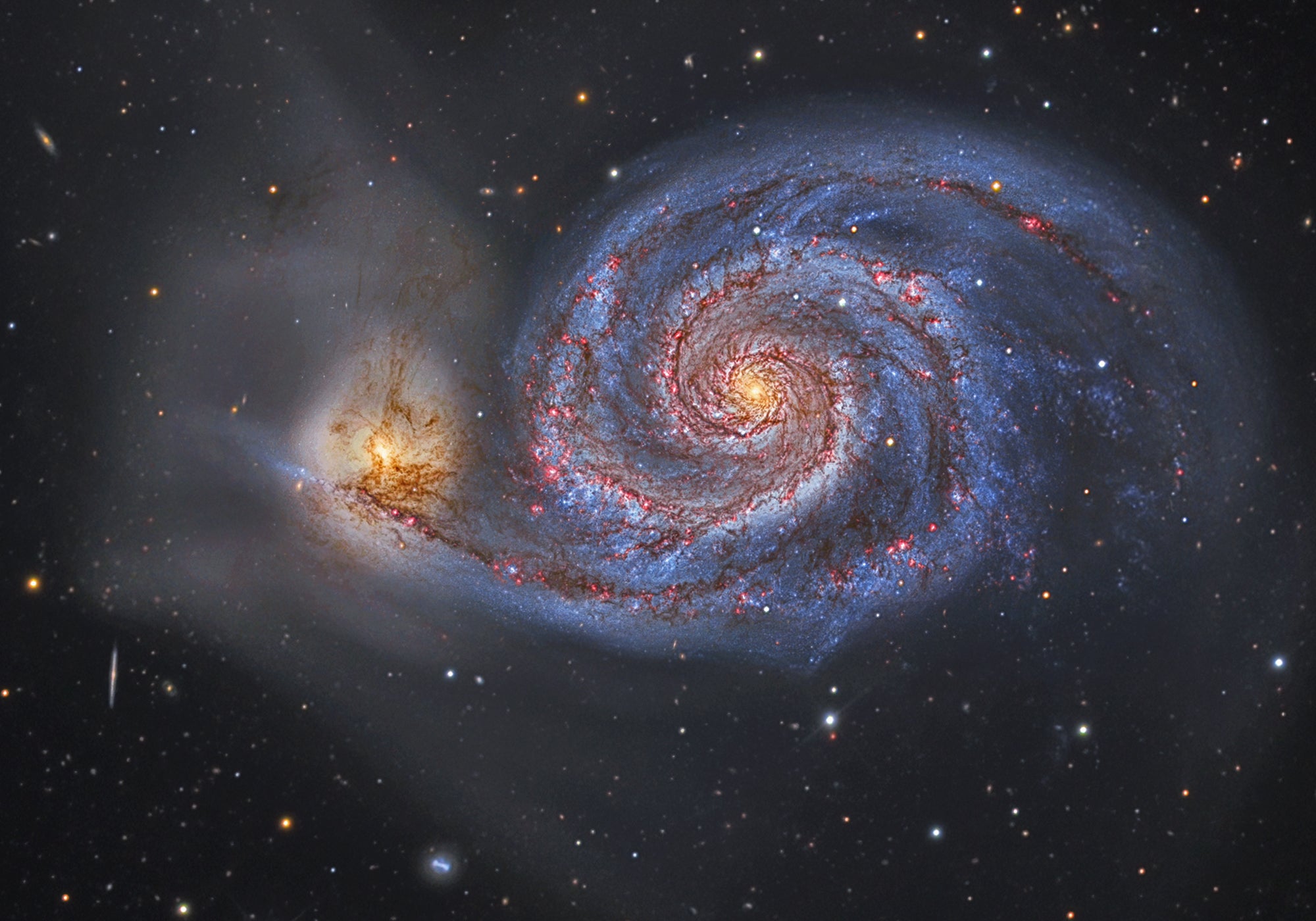Most emission nebulae are the sites of recent star formation, where hot, energetic radiation streaming from the newborn stars sculpts a nebula’s bright and dark clouds into intriguing (and sometimes mystifying) shapes. These shapes have led to many of these objects’ fanciful monikers, such as the Lagoon Nebula or the Pillars of Creation.
Early May: early evening
NGC 2174–5. Popularly known as the Monkey Head Nebula, NGC 2175 is a 30′-wide nebulous cluster 6,400 light-years distant in the hinterlands of the Orion Milky Way. In visible light, NGC 2175 is a rosebud of rippling emission excited by a magnitude 6.5 star and centered on what appears to be an embedded cluster. But recent observations have shown this is an illusion, as the NGC 2175 cluster is actually not a star cluster but an extended stellar group of four cluster components within the Gemini OB1 association. The cluster complex formed within NGC 2174 during a lingering starburst event some 5 million years ago. Infrared views of the largely spherical nebula’s dense western edge show a ragged ridge of dust and gas sculpted into a tiered landscape of dark foothills and misty mountaintops where star formation is most likely still happening.
You’ll find this exotic wonder about 1° east and slightly north of Chi2 (χ2) Orionis, near the northern foot of Gemini. The ghostly glow is most comfortably viewed through binoculars under a dark sky. Look for an irregular sphere of misty “moonlight” seen against a rich Milky Way background.
What’s weird about this object is that the enormous nebula’s brightest patch, NGC 2174, requires a telescope to see, as it is but an itsy-bitsy (3′ wide) enhancement on NGC 2175’s northern rim. This swab of gas lies just 10′ north-northwest of the embedded cluster’s magnitude 6.5 central star and covers a tight gathering of 11th- to 12th-magnitude stars arranged in a north-south line. Large sweeps across the nebula’s face with a large telescope will also show the nebula’s faint alternating bands of dark and light.
Sharpless 2–235. This peculiar kidney bean-shaped star-forming region lies some 6,500 light-years away in the Perseus spiral arm of our Milky Way. It lies in the direction of the galactic anticenter, just north of open cluster M36 in Auriga.
In optical images, the nebula appears as a small and nearly structureless glowing cloud whose northern half shines more brightly than its southern half. A dark lane of dust separates the two hemispheres, making it look as if the brighter section is being mirrored in a pool of water.
Sh 2–235 is a fine target for those using 10-inch and larger telescopes, which at 100x will show the bifurcated nebula as a pale 10′ oval glow with a dark band separating its two disparate halves. But skilled observers have spied the nebula using a 5-inch telescope, so try your luck.
NGC 1931. The Little Orion Nebula is an 8th-magnitude nebulous cluster about 1° west of open cluster M36. Born from a very dense and dusty environment some 7,500 light-years away, the nebula sports a central hollow cleared by radiation from a young, hot trapezium of stars and outer looping bands of dust and gas that glow with molecules of polycyclic aromatic hydrocarbons; these ubiquitous molecules are known to astronomers as the prebiotic roots of life.
So in shape and structure, NGC 1931 resembles a miniature Orion Nebula. Actually, data from the Two Micron All Sky Survey have shown the nebula does not harbor a single cluster but a double cluster: the NGC 1931 cluster and a much fainter stellar gathering to the south near the edge of the hollow. This suggests NGC 1931 is either evolving into an OB association or dissolving slowly into the Milky Way.
Through a 5-inch telescope at powers ranging from 165x to 330x, the nebula has a smooth, milky sheen that gradually, then rapidly, fades away from the bright cluster core. The southern end is more condensed than the northern end, which is partly obscured by the region’s large, expansive, and dense molecular cloud.
NGC 1491 is an example of a “blister” type H II region, or one formed in a heterogeneous environment. (In this case, on the lip of a dense molecular cloud.) Intense stellar winds from its hot exciting star are “blowing” a bubble in the gas, which is bursting through the molecular cloud’s edge, like a blister, clearing out its environment. The exiting star’s ultraviolet radiation is also sending out a rapidly expanding shock wave (the half-ring of light) that’s washing through the edge of the molecular cloud like a tidal wave intercepting a coastal plain.
You’ll find NGC 1491 about 1° northwest of 4th-magnitude Lambda (λ) Persei. It’s visible through a 5-inch refractor under a dark sky as a distinct oval patch of irregular light. High magnifications will show two bright horns of gas northwest of the exciting star against a wider and less-condensed skirt of light.
NGC 6813. This tiny (2′) mote of emission nebulosity all but pleads to be noticed among the rich stellar sands of the Vulpecula Milky Way. Little is known about its true physical nature. It’s been classified as an emission nebula, but some databases refer to it simply as “interstellar matter.” Nevertheless, it does contain a Westerhout radio source (W54) within a significant star-forming region that includes an infrared cluster cataloged as BDS2003.
You’ll find this mystery spot about 2¼° east-southeast of Albireo (Beta [β] Cygni) and about 20′ west of a 7th-magnitude star. Amateur astronomers have done admirably in imaging it, and those who have spied it visually have been astounded by its tiny intensity. It is visible to a skilled observer through a 4-inch telescope at 150x, but don’t hesitate to pump up the power if you’re having difficulty. Its bright center shines around 11th magnitude and has a flattened appearance, oriented east-west.
NGC 6820. An expansive emission and reflection nebula near 5th-magnitude 12 Vulpeculae, NGC 6820 surrounds the 7th-magnitude open cluster NGC 6823, whose Trapezium-like core of hot central stars excites the nebula while clearing away a central cavity. Beyond this central hollow, a battle between light and dark appears to take place on all fronts: A massive jagged slash of dark nebulosity carves across the nebula’s faint northwestern flank; a fist of dark matter punches in from the east (with pointy black fingers clawing inward toward the central cavity); and to the south, dark stalagmites of obscuring dust jut from an anemic nebulosity that droops southward like a pouting lip. With imagination, the scene looks like a wilted rose melting in the heat.
Although the nebula has been spied in 15×100 binoculars, its visibility greatly depends on the sky’s clarity, light pollution, aperture, and magnification. Through a 5-inch rich-field telescope under a dark sky at 22x, it’s but a suspicion of light around the 30′-wide L-shaped cluster, whose halo of fainter stars mingles with the slightly larger (and extremely pale) emission nebula. Others using twice that aperture have reported seeing finer details.
Sharpless 2–82. This small (7′) and dim emission and reflection nebula lies some 3,500 light-years away in northwestern Sagitta. In images it’s reminiscent of a miniature Cocoon or Trifid Nebula blooming from the center of a long river of dark nebulosity. In terms of color, the scene is most peculiar. The pink emission nebula appears to lie in a nest of blue reflection nebulosity, through which threads of dark nebulae (streaming off the dark river) weave in and out, as if trying to sew the two glows together. Also curious, the dark river’s southwestern segment seems to pass in front of and occlude the nebula, while its fainter northeastern extension appears to lurk dimly behind it.
IC 5068. You can find this sizable (30′) emission nebula about 1° south of the Pelican Nebula in Cygnus. I call it the Black Waterfall because in images, multiple rivulets of dark matter cascade across its face like feathery water. It’s an unusual sight, making one wonder about the chaos responsible for causing such visual delight.
IC 5068 is but a ridge of gaseous emission with dark clouds of cool gas invading its borders. It’s all part of a single large H II region 1,800 light-years distant that includes the North America and Pelican nebulae. A dark absorption cloud (LDN 935) sweeps through this entire area like a Death Eater from the Harry Potter series, sucking light from distant stars and rendering them invisible.
Through a 5-inch at 22x, IC 5068 is a pale wash of rectangular light sweeping past a 7th-magnitude central illuminating star. Through an 18-inch at 100x, it appears as three irregular parallel strips of pale light stretching roughly east-west and separated by dark nebulosity.
NGC 6334. Popularly known as the Cat’s Paw Nebula, NGC 6334 is one visual definition of weird: a bubbling mix of nebulous porridge that just may be one of the most productive star-forming regions in the Milky Way. Astronomers believe this roiling complex, some 5,500 light-years away in the Scorpius Milky Way, is undergoing a tremendous episode of starburst in its central region; tens of thousands of newborn stars may have already “burst” onto the scene along a central radial filament in what astronomers are calling an interstellar “baby boom.” The Cat’s Paw is visible in 4-inch and larger telescopes and shares the field with the dark nebula Barnard 257. NGC 6334 is a simple sight — essentially three fragmented patches of dim light forming a triangle of uniform glows. The brightest patch surrounds a roughly 9th-magnitude star.
Naked-eye nebula
IC 1396. This is one of the largest emission nebulae north of the celestial equator. It’s a vast shell-shaped star-forming region (3° wide) nearly 3,000 light-years away in southern Cepheus, just 1½° south-southwest of the 4th-magnitude orange gem Mu (μ) Cephei, also known as Herschel’s Garnet Star. The glow encompasses the sprawling open star cluster Trumpler 37, which lies in the core of the Cepheus OB2 association.
Here we have a massive Rosette-type nebula, complete with a central hollow and numerous splotches of dark nebulae littered across its entire face, looking like Indonesian shadow puppets tossed asunder. One of these bleak features is a dark and dense globule on the nebula’s western edge known as the Elephant’s Trunk. It marks one site of active star formation where radiation and winds from the nebula’s hot O-type central star are compressing parts of the cloud and triggering star formation.
Under dark skies, IC 1396 can be seen with the naked eye and somewhat more easily spotted in 7×50 binoculars. Through a 4-inch rich-field telescope, it is a definite telescopic glow, especially if you sweep the scope across the nebula’s vast expanse while using averted vision. Observers using larger telescopes have often likened it to a large and very faint Rosette Nebula. Several of its dark nebulae can also be spied through small telescopes under dark skies.
Looking for emission nebulae is like passing through time to see visual traces of uninhibited creation. It is akin to seeing a Monet or Picasso exposed, yet unfinished. Yes, all of this is left to the workings of a visual observer’s imagination, but with the remarkable imaging produced by today’s amateurs, not to mention by orbiting spacecraft, we have much food for thought. Enjoy.

